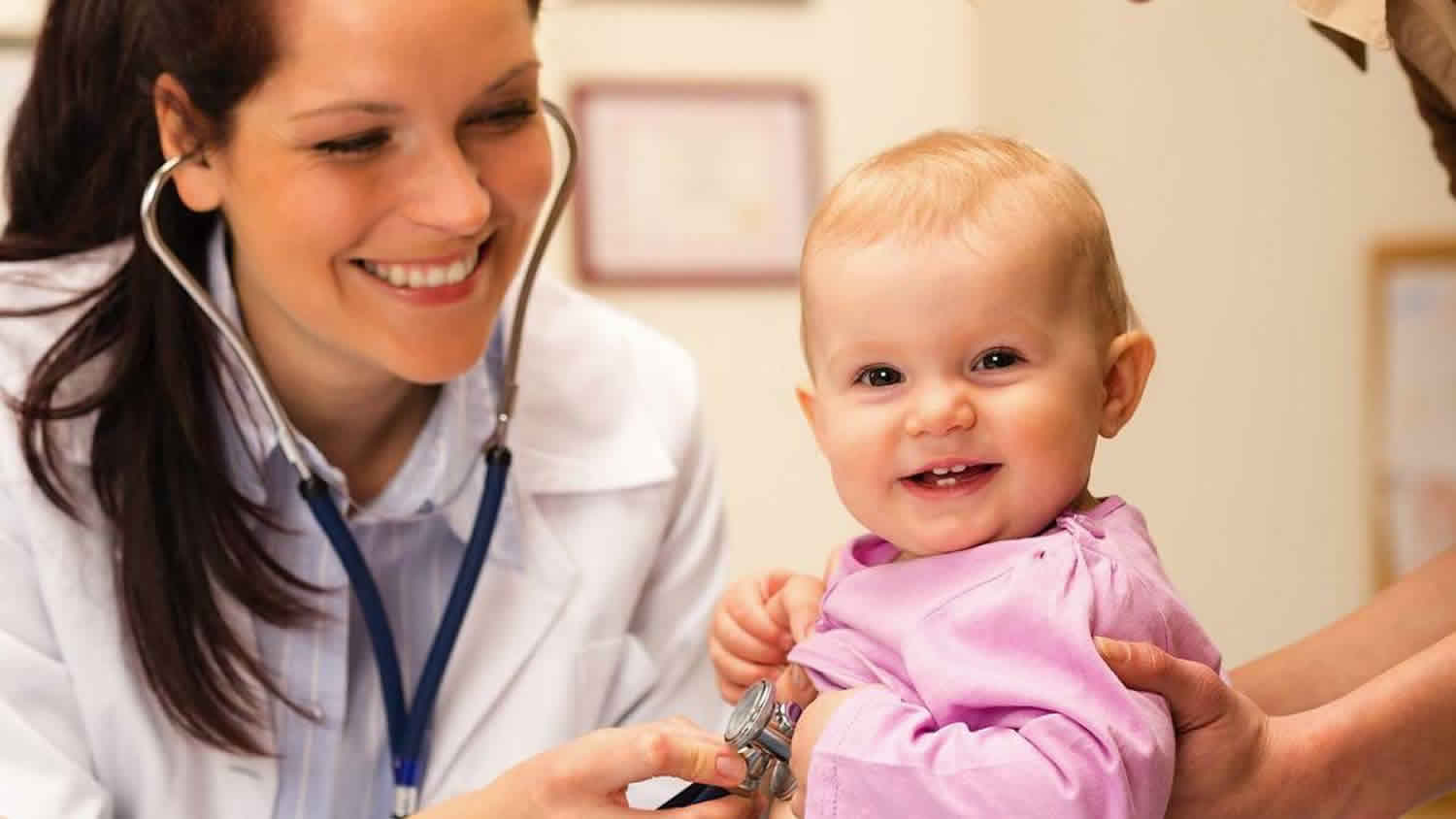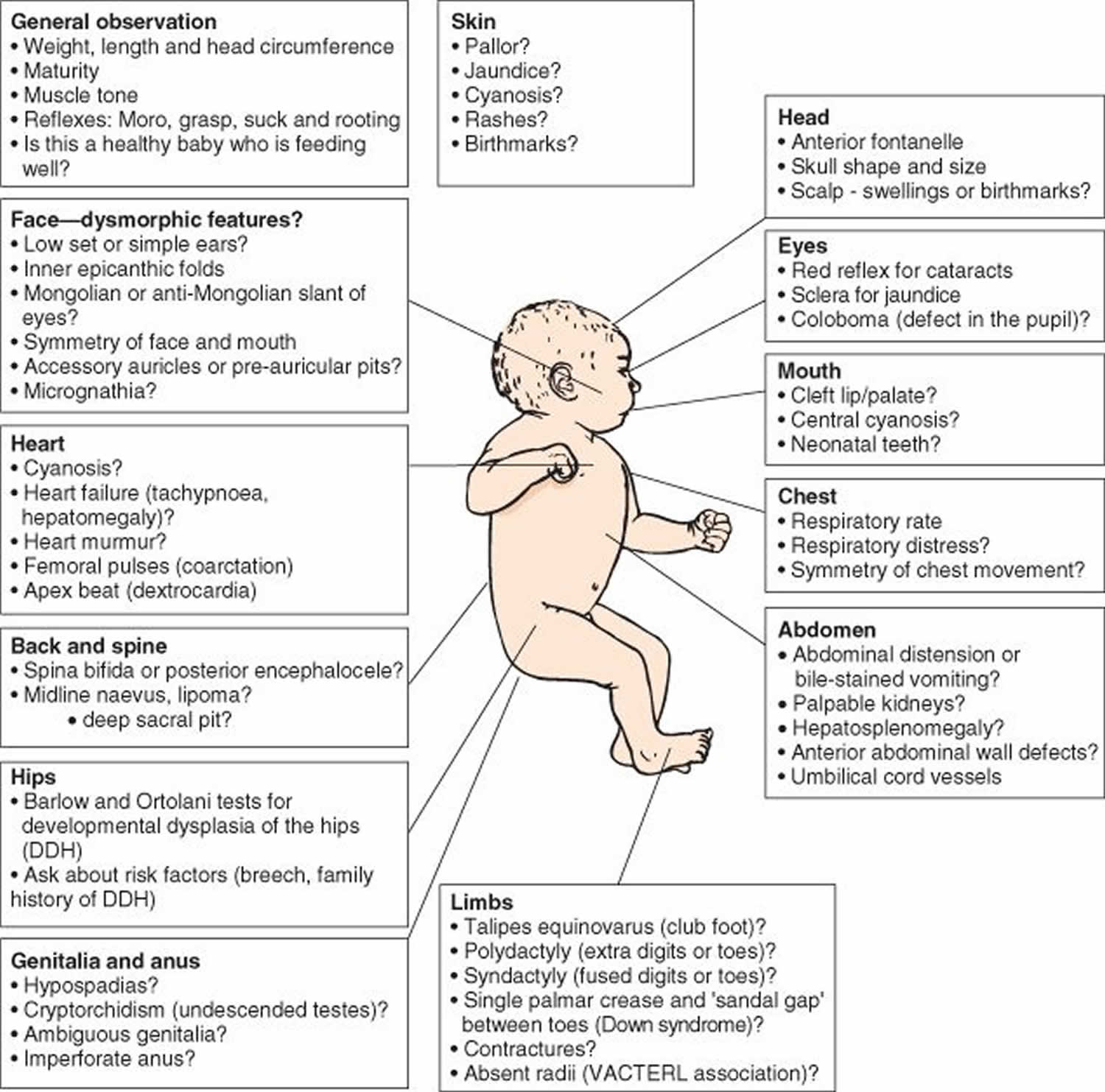Newborn assessment
Routine newborn assessment is a broad term referring to the assessment of the newborn occurring at various points in time within the first 6–8 weeks after birth. Newborn assessment includes the brief initial assessment, the full and detailed newborn assessment within 48 hours of birth and the follow-up assessments at 5–7 days and 6 weeks.
Each newborn baby is carefully checked at birth for signs of problems or complications. Your child’s healthcare provider will do a complete physical exam that includes every body system. Throughout the hospital stay, doctors, nurses, and other healthcare providers continually look at the health of your baby. They are watching for signs of problems or illness. Newborn assessments may include the below.
Routine newborn assessment:
- General appearance
- Skin color, integrity, perfusion
- State of alertness
- Activity and range of spontaneous movement
- Posture and, muscle tone
- Growth status
- Chart head circumference, length and weight on centile charts
- Head, face, neck
- Head shape, size
- Scalp, fontanelles, sutures
- Eye size, position structure
- Nose, position, structure
- Ear position, structure
- Mouth, palate, teeth, gums tongue, frenulum
- Jaw size
- Shoulders, arms, hands
- Length, proportions, symmetry
- Structure, number of digits
- Chest
- Size, shape, symmetry, movement
- Breast tissue, nipples
- Heart sounds, rate, pulses. A newborn baby’s normal heart rate ranges from 90 to 140 beats per minute.
- Breath sounds, respiratory rate.
- Pulse oximetry
- Abdomen
- Size, shape, symmetry
- Palpate liver, spleen, kidneys
- Umbilicus
- Genitourinary
- Male – penis, foreskin, testes
- Female – clitoris, labia, hymen
- Anal position, patency
- Passage of urine, stool
- Hips, legs, feet
- Ortolani and Barlow’s manoeuvers
- Leg length, proportions, symmetry and digits
- Back
- Spinal column, skin
- Symmetry of scapulae, buttocks
- Neurological
- Behavior, posture
- Muscle tone, spontaneous movements
- Cry
- Reflexes – Moro, Suck, Grasp
Measurements
The hospital staff takes other measurements of each baby. These include:
- Head circumference. The distance around the baby’s head.
- Abdominal circumference. The distance around the belly (abdomen).
- Length. The measurement from top of head to the heel.
The staff also checks these vital signs:
- Temperature. This checks that the baby is able to have a stable body temperature in normal room.
- Pulse. A newborn’s pulse is normally 120 to 160 beats per minute.
- Breathing rate. A newborn’s breathing rate is normally 40 to 60 breaths per minute.
Physical exam
A complete physical exam is an important part of newborn care. The healthcare provider carefully checks each body system for health and normal function. The provider also looks for any signs of illness or birth defects. Physical exam of a newborn often includes:
- General appearance. This looks at physical activity, muscle tone, posture, and level of consciousness.
- Skin. This looks at skin color, texture, nails, and any rashes.
- Head and neck. This looks at the shape of head, the soft spots (fontanelles) on the baby’s skull, and the bones across the upper chest (clavicles).
- Face. This looks at the eyes, ears, nose, and cheeks.
- Mouth. This looks at the roof of the mouth (palate), tongue, and throat.
- Lungs. This looks at the sounds the baby makes when he or she breathes. This also looks at the breathing pattern.
- Heart sounds and pulses in the groin (femoral)
- Abdomen. This looks for any masses or hernias.
- Genitals and anus. This checks that the baby has open passages for urine and stool.
- Arms and legs. This checks the baby’s movement and development.
Apgar scoring
The Apgar score helps find breathing problems and other health issues. It is part of the special attention given to a baby in the first few minutes after birth. The baby is checked at 1 minute and 5 minutes after birth for heart and respiratory rates, muscle tone, reflexes, and color. A baby who needs help with any of these issues is getting constant attention during those first 5 to 10 minutes. In this case, the actual Apgar score is given after the immediate issues have been taken care of.
Each area can have a score of 0, 1, or 2, with 10 points as the maximum. Most babies score 8 or 9, with 1 or 2 points taken off for blue hands and feet because of immature circulation. If a baby has a difficult time during delivery and needs extra help after birth, this will be shown in a lower Apgar score. Apgar scores of 6 or less usually mean a baby needed immediate attention and care.
Table 1. Apgar score
| Sign | Score = 0 | Score = 1 | Score = 2 |
| Heart rate | Absent | Below 100 per minute | Above 100 per minute |
| Breathing effort | Absent | Weak, irregular, or gasping | Good, crying |
| Muscle tone | Flaccid | Some flexing of arms and legs | Well-flexed, or active movements of arms and legs |
| Reflex or irritability | No response | Grimace or weak cry | Good cry |
| Color | Blue all over, or pale | Body pink, hands and feet blue | Pink all over |
Birth weight
A baby’s birth weight is an important marker of health. Full-term babies are born between 37 and 41 weeks of pregnancy. The average weight for full-term babies is about 7 pounds (3.2 kg). In general, very small babies and very large babies are at greater risk for problems. Babies are weighed every day in the nursery to look at growth, and the baby’s need for fluids and nutrition. Newborn babies may often lose 5% to 7% of their birth weight. This means that a baby weighing 7 pounds 3 ounces at birth might lose as much as 8 ounces in the first few days. Babies will usually gain this weight back within the first 2 weeks after birth. Premature and sick babies may not begin to gain weight right away.
Most hospitals use the metric system for weighing babies. This chart will help you convert grams to pounds.
Converting grams to pounds and ounces:
1 lb. = 453.59237 grams; 1 oz. = 28.349523 grams; 1000 grams = 1 Kg.
Gestational assessment
The healthcare provider will check how mature the baby is. This is an important part of care. This check helps figure out the best care for the baby if the dates of a pregnancy are uncertain. For example, a very small baby may actually be more mature than he or she appears by size, and may need different care than a premature baby needs.
Healthcare providers often use an exam called the Dubowitz/Ballard Examination for Gestational Age. This exam can closely estimate a baby’s gestational age. The exam looks at a baby’s skin and other physical features, plus the baby’s movement and reflexes. The physical maturity part of the exam is done in the first 2 hours of birth. The movement and reflexes part of the exam is done within 24 hours after birth. The provider often uses the information from this exam to help with other maturity estimates.
Physical maturity
The physical maturity part of the Dubowitz/Ballard exam looks at physical features that look different at different stages of a baby’s gestational age. Babies who are physically mature usually have higher scores than premature babies.
Points are given for each area of assessment. A low of -1 or -2 means that the baby is very immature. A score of 4 or 5 means that the baby is very mature (postmature). These are the areas looked at:
- Skin textures. Is the skin sticky, smooth, or peeling?
- Soft, downy hair on the baby’s body (lanugo). This hair is not found on immature babies. It shows up on a mature infant, but goes away for a postmature infant.
- Plantar creases. These are creases on the soles of the feet. They can be absent or range up to covering the entire foot.
- Breast. The provider looks at the thickness and size of breast tissue and the darker ring around each nipple (areola).
- Eyes and ears. The provider checks to see if the eyes are fused or open. He or she also checks the amount of cartilage and stiffness of the ears.
- Genitals, male. The provider checks for the testes and how the scrotum looks. It may be smooth or wrinkled.
- Genitals, female. The provider checks the size of the clitoris and the labia and how they look.
Maturity of nerves and muscles
The healthcare provider does 6 checks of the baby’s nerves and muscles.
A score is given to each area looked at. Typically, the more mature the baby is, the higher the score. These are the areas checked:
- Posture. This looks at how the baby holds his or her arms and legs.
- Square window. This looks at how far the baby’s hands can be flexed toward the wrist.
- Arm recoil. This looks at how much the baby’s arms “spring back” to a flexed position.
- Popliteal angle. This looks at how far the baby’s knees extend.
- Scarf sign. This looks at how far the baby’s elbows can be moved across the baby’s chest.
- Heel to ear. This looks at how near the baby’s feet can be moved to the ears.
When the physical assessment score and the nerves and muscles score are added together, the healthcare provider can estimate the baby’s gestational age. Scores range from very low for immature babies to very high scores for mature and postmature babies.
All of these exams are important ways to learn about your baby’s well-being at birth. By finding any problems, your baby’s doctor can plan the best possible care.






